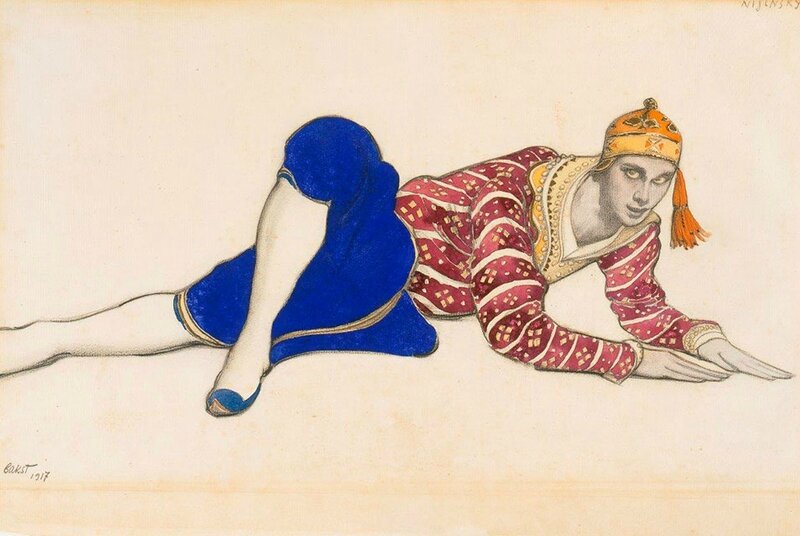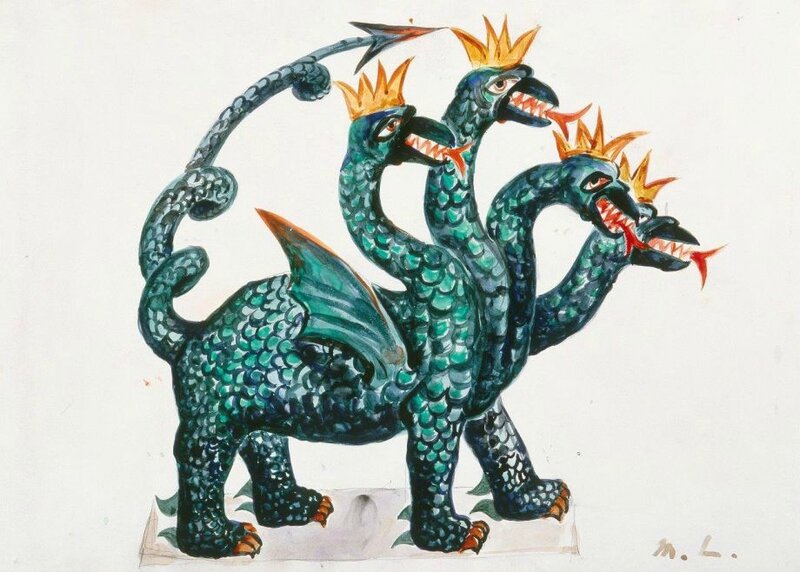All the Rage in Paris: Diaghilev's Ballets Russes' on view at the McNay Art Museum
Leon Bakst, Costume design for Vaslav Nijinsky as Chinese Dancer in Les Orientales, 1917. Watercolor and graphite on paper. Gift of the Tobin Foundation for Theatre Arts, TL1998.34. Photo: Courtesy McNay Art Museum / Courtesy McNay Art Museum.
SAN ANTONIO, TX.- A grand finale exhibition to the McNay’s 60th anniversary celebration, All the Rage in Paris focuses on Serge Diaghilev’s Ballets Russes, the company that brought theatre—and theatre design—to the center of artistic life in Europe from 1909 to 1929. Conceived as a showcase for Russian art and artists, the Paris-based company also embraced the latest trends in literature, music, dance, and visual art, revolutionizing dance and captivating audiences in London, New York, and beyond.
Thanks to the foresight of Robert L. B. Tobin, the McNay’s theatre arts collection features artists at the heart of Diaghilev’s company: Alexandre Benois, Léon Bakst, Natalia Gontcharova, and Mikhail Larionov. Their scene and costume designs reveal the shifting tastes and talents that defined the Ballets Russes, from the oriental exoticism of Rimsky-Korsakov’s Schéhérazade, to the Russian folklore of Stravinsky’s Petrouchka, and the courtly spectacle of Tchaikovsky’s The Sleeping Princess.
Mikhail Larionov, Costume design for Dragon in "Russian Fairy Tales", circa 1917. Photo: Courtesy McNay Art Museum / Courtesy McNay Art Museum
Actual costumes, from the McNay’s Tobin Collection of Theatre Arts and the Museum of Performance and Design in San Francisco bring the artists’ scene and costume drawings to life. Along with film footage of ballets in performance, the costumes suggest the explosion of color and movement that dazzled theatre-goers and influenced design well beyond the stage.
This exhibition is organized by the McNay Art Museum and is a program of the Tobin Theatre Arts Fund.
Natalia Gontcharova, Front curtain design for Act III, scene 3, in Le Coq d’Or (The Golden Cockerel), ca. 1914. Watercolor, gouache, and graphite on board. Gift of Robert L. B. Tobin, TL1998.177.© Artists Rights Society (ARS), New York/ ADAGP, Paris.
Design, Fashion, Theatre: The Art of Pochoir in France, 1910-1930
February 18 | June 21, 2015
Pochoir, a hand stenciling technique that produces vibrant colors and bold patterns, flourished in the period of the Ballets Russes As rare volumes and portfolios from the Tobin Collection reveal, pochoir became the printmaking medium of choice for publishing Diaghilev’s ballets and publicizing the fashions they inspired. Bakst’s harem pants and turbans for Schéhérazade, for example, made their way from the stage to the salon of couturier Paul Poiret. Diaghilev’s designers created pochoir editions of their own work, inspiring generations of artists with Modern Theatrical Art and Compositions, Colors, Ideas.
This exhibition is organized by the McNay Art Museum and is a program of the Tobin Theatre Arts Fund.
Leon Bakst, Variation of the original scene design for Schéhérazade, after 1910. Watercolor, metallic paint, and graphite on paper. Collection of the McNay Art Museum, Gift of Robert L.B. Tobin. Photo: Courtesy McNay Art Museum / Courtesy McNay Art Museum.

/https%3A%2F%2Fprofilepics.canalblog.com%2Fprofilepics%2F1%2F0%2F100183.jpg)
/https%3A%2F%2Fstorage.canalblog.com%2F03%2F02%2F119589%2F96711876_o.jpg)
/https%3A%2F%2Fstorage.canalblog.com%2F11%2F31%2F119589%2F94773502_o.jpg)
/https%3A%2F%2Fstorage.canalblog.com%2F20%2F83%2F119589%2F94772815_o.jpg)
/https%3A%2F%2Fstorage.canalblog.com%2F26%2F72%2F119589%2F75604929_o.jpg)
/https%3A%2F%2Fstorage.canalblog.com%2F59%2F60%2F119589%2F26458628_o.jpg)






/http%3A%2F%2Fstorage.canalblog.com%2F79%2F28%2F119589%2F114770721_o.jpg)
/http%3A%2F%2Fstorage.canalblog.com%2F57%2F37%2F119589%2F111150116_o.jpg)
/http%3A%2F%2Fstorage.canalblog.com%2F22%2F01%2F119589%2F109862282_o.jpg)
/http%3A%2F%2Fstorage.canalblog.com%2F60%2F87%2F119589%2F112018167_o.jpg)